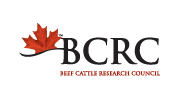Do synthetic hormones used in beef production have environmental effects when excreted?
| Project Code: | ENV.09.17 |
| Completed: | In Progress. Results expected in March 2021. |
Project Title:
Assessment of occurrence of synthetic hormones (melengestrol acetate and trenbolone acetate) and beta-agonist (ractopamine) in cattle operations and associated environments
Researchers:
Francis Larney, Ph.D. and Paul Jones Ph.D. francis.larney@agr.gc.ca
Francis Larney, Ph.D. (Agriculture Agri-Food Canada Lethbridge); Paul Jones Ph.D. (University of Saskatchewan); Tim McAllister Ph.D., and Srinivas Sura Ph.D. (Agriculture Agri-Food Canada), John Giesy Ph.D. (University of Saskatchewan)
Background:
Natural growth promotants (estrogen, testosterone, progesterone) and synthetic growth promotants (zeranol, trenbolone acetate TBA, melengesterol acetate MGA, ractopamine RAC) are used to improve the growth rate and efficiency of cattle. They also have environmental benefits due to decreased resource use and greenhouse gas production. However, there are concerns that growth promotant residues excreted in manure or urine may have negative environmental effects, including potential hormone-disrupting effects that impact reproduction and development of fish and amphibians. Very little research has been done in Canada, and data from other countries may not reflect Canadian field conditions. Lab-based studies may use hormone or manure concentrations, temperature and pH conditions that are not representative of production or natural environments.
Objectives:
To quantify concentrations of MGA, TBA, RAC and their metabolites in feces and manure from cattle administered with these growth promoters, in surface runoff from pens, on cropland that has had manure spread on it, and in ground water in areas around feedlots. Researchers will also evaluate effectiveness of windrow composting and manure stockpiling in dissipating MGA, TBA, and RAC residues and evaluate endocrine disrupting effects of these compounds.
What They Will Do:
The researchers will measure MGA, TBA and RAC in fresh feces and manure as well as composted and stockpiled manure, feedlot catch-basins and soil. They will determine whether (and how far) these residues travel in water and soil, and how long it takes for these compounds and their break-down products to disappear.
120 heifers will be split into three groups, Control vs. MGA+TBA vs. MGA+RAC. 80 steers will also be used and divided into two groups; Control vs. TBA+RAC. All animals will be backgrounded (100 days) and finished (120 days). Repeated samples of fresh feces and manure will be collected and analyzed. These samples and analyses will also be carried out at commercial feedlots.
A rainfall simulator will be used to generate runoff and assess transport of compounds from the feedlot environment. Manure will be spread on soil that hasn’t received manure before, and the rainfall simulator will be used to assess potential metabolite transport from agricultural soils. Catch basin water from both research (AAFC) and commercial feedlots will be sampled and tested. Groundwater will be tested at the AAFC site to assess infiltration potential.
Repeated sampling and testing will be used to assess the effects of manure stockpiling and composting on the half-lives of these compounds and their breakdown products. Broadcast vs. incorporation of manure on agricultural soils will also be compared.
A human adenocarcinoma (glandular cancer) cell line that is very sensitive to hormones will be used to determine whether these residues or metabolites occur at high enough levels in the environment to impact estrogen or testosterone production.
Implications:
This project will close the knowledge gap about the potential for endocrine disrupting effects from levels of growth promotants or their metabolites typically found in the environment to provide sound science to guide Canada’s beef industry in appropriately responding to public concerns about modern beef production.








